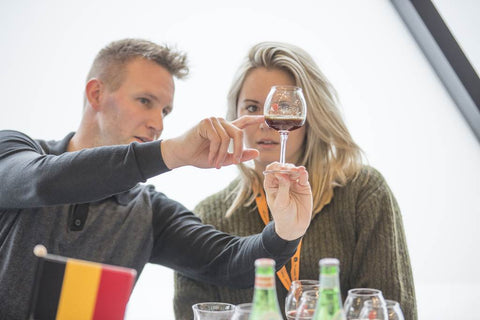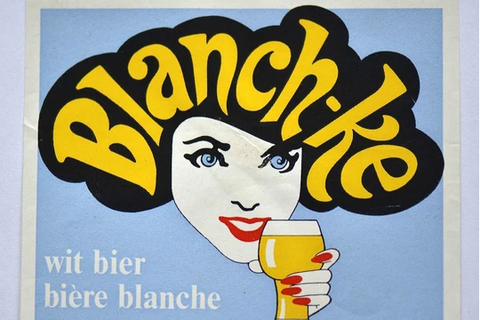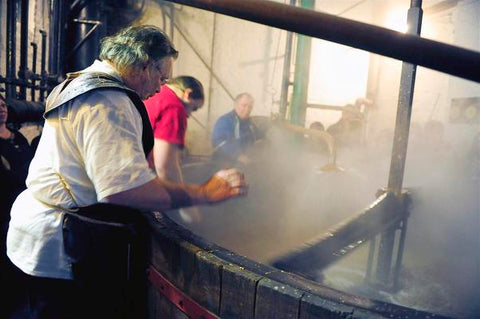- No products in the cart.
Beer Dictionary
A
- Abbey Beer
Fruity, strong Belgian ale that is modelled on the beers made by monks from Trappist abbeys, but brewed by secular brewers.
- ABV
Alcohol By Volume. This is a standard measure of the amount of alcohol in a drink. The average is around 4% to 5% but you can will easily find beers with an ABV as high as 12% or even more. The ABV of wine is usually around 12% to 14%. When alcohol content is measured by volume the figure will always be higher than when measured by weight. The calculation of the ABV of a beer can easily be done by subtracting the final gravity from the original gravity and dividing the result by 0.0075.
- ABW
Alcohol By Weight. A measurement of alcoholic strength based on the weight of the alcohol in a solution.
- Acrospire
The first shoot to appear when barley (or any other grain) germinates. The word acrospire came to replace the word akerspire which in its turn was derived from the Old English word for grain aechir.
- Adjunct
Any unmalted grain or other fermentable ingredient that is used in the brewing process. Typical adjuncts are either rice or maize (corn), but they can also include honey, syrup and other fermentable sources of carbohydrates.
- Aeration
The process of introducing air or oxygen to the wort during the brewing process. Aeration is essential to a vigorous fermentation and to safeguard the health of the yeast cells. It must be done before the primary fermentation to avoid harming the flavour of the beer. This is caused by oxidation and the flavour it creates can be compared to the taste of cardboard.
- Alcohol
A synonym for ethyl alcohol or ethanol, which is the colourless primary alcohol constituent of beer. This intoxicating substance is produced by fermentation of certain carbohydrates. Depending on the kind of drink these can be anything from sugar to grains or molasses. Alcohol can also be produced synthetically.
- Ale
Any beer that is brewed with top-fermenting yeast. These are brewed in warmer temperatures than lager beers. Fermentation is relatively quick and the beers tend to be sweet and strong and to have higher alcohol contents than lagers.
B
- Barley Wine
An English term for a very strong ale - typically 12.5% ABV.
- Black Beer
Unique to Brazil and developed by German settlers who used German methods of brewing using native ingredients.
- Beer
Any fermented drink that is made primarily from malted grain and seasoned with hops. In Belgium lagers, ales, stouts and many other styles are all beers. Americans tend to think of beer as beer while in the UK beer most often describes ale.
- Berliner Weisse
A refreshing light bodied style of Wheat Beer made in Berlin. It is low in alcohol and is served chilled as a summer quencher laced with a dash of raspberry syrup.
- Biere de Garde
An ale type beer from North-west France. It’s a medium to strong beer and best drunk with soft, sharp or herby cheeses.
- Bitter
A British style of dry ale, often served on draft. This is a sociable drink and traditionally is very popular in British pubs where it is usually drunk from a pint glass.
- Bock
A strong German lager served as a warming beer in late winter, early spring or autumn. Classically it is served in a stoneware mug and accompanied by seasoned veal sausage, Weisswurst.
- Bottom Fermentation
As opposed to Top Fermentation. With bottom fermentation the yeast cells sink to the bottom of the fermentation vessel. Beers brewed using this process are commonly called lagers.
- Brew Kettle
A vessel used in the brewing process in which the wort (unfermented beer) is boiled.
- Brown Ale
Made with fewer hops than bitter or pale ales. It is toffee-like in colour and in Britain there are two types with varying degrees of sweetness. In Belgium a similar type of beer is brewed around the town of Oudenaarde.
C
- Carbon Dioxide
The gas that is produced by yeast and what gives beer its bubbles.
D
- Dark Beer
A term that usually refers to the dark-coloured beer of Munich.
- Doppelbock
“Double bock”; like bock, only stronger.
- Dunkel
Another name for dark beer; dunkel means dark in German.
E
F
- Faro
A sweet version of Belgian Lambic.
- Fermentation
The process where the action of yeast causes fermentable sugars to be converted into approximately equal parts of ethyl alcohol and carbon dioxide gas. The two basic methods are Top Fermentation and Bottom Fermentation.
- Filtration
Where the brewing liquid is passed through a filter to remove suspended solid matter, usually yeast.
- Fining
The process of adding various clarifying agents to beer during secondary fermentation in order to hasten the precipitation of suspended matter. These agents can include isinglass, gelatine or silica gel.
G
- Grist
Ground malt and grains that are ready for mashing.
- Gueuze
Blended Lambic. Very popular in Belgium to drink with Sunday lunch.
H
- Hops
The flowers of the female hop plant are used in the brewing process to provide bitterness, light aromas and to improve keeping qualities.
- Hydrometer
A glass instrument used to measure the specific gravity of liquids as compared to water. Finding the specific gravity enables the alcohol content to be calculated.
I
- IPA
India Pale Ale is a super-premium pale ale that is usually very hoppy, with a distinct bitterness.
J
K
- Kölsch
A delicate, dry, fruity golden ale made in the Cologne area of Germany.
L
- Lager
In some countries most basic beers are known as lager, but it really applies to beers brewed using the bottom fermentation process that are then fermented for a longer period in cooler conditions.
- Lambic
This is a Belgian beer that is fermented spontaneously by wild yeasts that are in the atmosphere in particular regions of the country.
- Light Ale
In England this is very similar to Bitter, except that is bottled rather than being draft.
M
- Malt
Processed barley or wheat that has been steeped in water heated and allowed to germinate. It is later dried in kilns and this converts the insoluble starch to the soluble substances and sugars in malt. Malt provides the body and alcohol of the beer.
N
O
- Oasthouses
Buildings on farms where picked hops are dried and later bailed.
P
- Pale Ale
A fruity copper-coloured style of ale that originated in England,
- Pilsener
Pilsener or Pils gets its name from the Czech city of Plzen This is classically a super-premium pale lager with a fragrant, flowery bouquet, a soft palate and an elegantly dry hoppy finish. The term is widely used to apply to any dry pale lager.
- Porter
Originally from London, this dark, almost black, fruity, dry, top fermented ale is well hopped and made from roasted unmalted barley. Traditionally drunk with oysters.
Q
R
- Rauchbier
A smoked lager produced especially around the Bavarian town of Bamberg and elsewhere in Franconia.
S
- Scotch Ale
These ales tend to be malty and strong.
- Stout
An almost black brew made by top fermentation. English stout is often sweet and is regarded as being a good mid-afternoon restorative. The more famous Irish Stout (Guinness) is intense, sociable and regarded as being wonderful with oysters.
T
- Top Fermentation
One of the two basic fermentation methods characterised by the yeast cells rising to the surface of the fermentation vessel. Ale yeast is top fermenting, while Lager yeast is bottom fermenting. Top fermented beers are known as Ales.
- Trappist Beer
These are strong, fruity, yeast sedimented ales brewed by Trappist monks in Belgium and the Netherlands. The beers are triple fermented and some have a port-like character. They should be treated with reverence.
U
V
W
- Wort
This is the liquid that is extracted from the mashing process during the brewing of beer. Wort contains the sugars that will be fermented by the brewing yeast to produce alcohol.
X
Y
- Yeast
Without yeast there would be no fermentation and no beer. It is yeast that converts the natural malt sugars into alcohol and carbon dioxide. Yeast was first viewed under a microscope in 1680 by the Dutch scientist Antonie van Leeuwenhoek.





